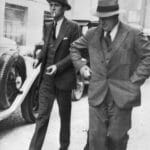Step back in time to the eerie 1980s, where a chilling tale unfolded on the West Coast. Randall Woodfield, a former football star turned serial killer, emerged as the infamous I-5 Bandit. He left a haunting trail of fear, unsolved mysteries, and shattered lives. In this article, we delve into the unsettling story of the I-5 Bandit and explore how his crimes continue to cast a long shadow.
The Elusive Phantom of Fear
In the early 1980s, a wave of terror swept across the West Coast, leaving communities on edge. The I-5 Bandit, a mysterious figure, became the subject of whispers and nightmares. His crimes were as diverse as they were terrifying, ranging from robberies and assaults to murders. The lack of a discernible pattern only amplified the fear.
Initially, the I-5 Bandit primarily targeted businesses like gas stations and stores. However, his crimes soon escalated to attacks on women, often discovered face-down with fatal gunshot wounds to the back of the head. The randomness and brutality of his actions left law enforcement struggling to grasp his motives or predict his next move.
A Pattern Emerges
Catching the I-5 Bandit proved to be a daunting task for law enforcement. His elusive nature and seemingly random movements made him a ghost-like figure. However, as investigators delved deeper into the case, they began to notice a chilling pattern in his interactions with women. It appeared he would often initiate contact with seemingly harmless requests before escalating to violence. This disturbing observation, though unsettling, provided a crucial lead in building a profile of the man they were hunting.
Unveiling the captivating tale of the formidable jeanne de clisson, a woman fueled by vengeance and fury who became a scourge for the French navy during the Hundred Years’ War. Alternatively, immerse yourself in the thrilling world of gangsterism with the story of Jack “Legs” Diamond, a notorious mobster who left an indelible mark on the annals of American crime.
Behind the Mask: Randall Woodfield
The I-5 Bandit was eventually unmasked as Randall Woodfield, a seemingly ordinary man with a dark secret. While outwardly appearing normal, a closer examination of Woodfield’s past revealed a history of troubling behavior. This included inappropriate sexual conduct and brushes with the law, suggesting a deeply troubled individual. Some experts, although they never formally diagnosed him, have speculated that Woodfield may have suffered from a personality disorder or experienced a traumatic childhood event that contributed to his violent tendencies.
Though Woodfield was linked to numerous crimes, he was ultimately convicted of only one murder and sentenced to life in prison. Despite his incarceration, the fear he instilled persists, particularly among the families of victims whose cases remain unsolved. They may never have the closure of knowing the full truth about what happened to their loved ones.
A Community Scarred
The I-5 Bandit’s reign of terror left an enduring scar on the communities he terrorized. The fear was palpable, as residents lived in a constant state of anxiety, wondering if they or someone they knew would be the next victim. The case highlighted the vulnerability of small towns and the darkness that can lurk beneath even the most seemingly ordinary facades.
How Did Randall Woodfield Get Caught?
The capture of Randall Woodfield, the I-5 Bandit, was a combination of meticulous police work and a stroke of luck. While investigators had been diligently piecing together clues and developing a profile of the elusive criminal, a routine traffic stop outside a bar proved to be his undoing.
The Role of a Composite Sketch
Prior to the fateful traffic stop, detectives had been working tirelessly, interviewing witnesses and collecting evidence. These often-emotional and challenging interviews led to the creation of a composite sketch of the suspect. This image, constructed from the fragmented memories and descriptions of those who had encountered the I-5 Bandit, would prove to be instrumental in his capture.
A Lucky Break
As fate would have it, officers conducting the traffic stop recognized Woodfield from the composite sketch. This seemingly mundane encounter, a simple check for a traffic violation, marked a turning point in the investigation. The sketch, a testament to the power of both human memory and artistic skill, played a crucial role in bringing an end to the I-5 Bandit’s reign of terror.
Damning Evidence
The traffic stop yielded more than just a visual identification. A search of Woodfield’s vehicle uncovered a wealth of incriminating evidence. Stolen items, directly linking him to multiple crime scenes, including those of his murders, were found within his possession. This physical evidence, coupled with the positive identification from the composite sketch, provided overwhelming proof of Woodfield’s guilt.
The I-5 Corridor: A Hunting Ground
The I-5 Bandit’s consistent modus operandi of targeting women along Interstate 5, spanning a vast distance, provided a crucial geographic link for investigators. This pattern suggested that Woodfield was not simply committing random acts of violence but was instead selecting his victims and locations with chilling deliberation. The I-5 corridor, a major artery connecting communities along the West Coast, had become his hunting ground.
Significance of the Capture
The capture of Randall Woodfield stands as a powerful testament to the importance of seemingly small details. A witness taking the time to describe a face, an artist’s ability to translate those words to paper, and an officer’s attentiveness during a routine stop all culminated in bringing a dangerous criminal to justice. The case serves as a reminder that even amidst fear and uncertainty, every effort to provide information, no matter how insignificant it may seem, can have a significant impact.
Furthermore, the I-5 Bandit case highlights the critical role of meticulous police work in solving complex crimes. The investigation was not solely reliant on the lucky break of the traffic stop but was built on a solid foundation of painstakingly collected evidence, analyzed patterns, and the relentless pursuit of justice.
What Happened to Beth Wilmot?
Randall Woodfield’s criminal history was marked by a pattern of escalating violence, with his crimes becoming increasingly brutal over time. On January 18, 1981, his reign of terror reached a horrifying peak in Keizer, Oregon. He attacked two young women, 20-year-old Beth Wilmot and 20-year-old Shari Hull, in an office building. The attack was brutal, and Shari Hull tragically lost her life to her injuries.
Beth Wilmot, however, miraculously survived despite being shot in the head. Her survival was a testament to her strength and resilience. She was able to provide crucial information to the police, helping them piece together the events of the attack and identify her attacker. Wilmot later bravely identified Woodfield in a police lineup, a pivotal moment that played a significant role in bringing him to justice.
Conclusion
The story of the I-5 Bandit is a chilling reminder that evil can lurk beneath the surface of seemingly ordinary lives. The case serves as a cautionary tale, urging us to be vigilant and aware of our surroundings. It also highlights the courage and resilience of victims like Beth Wilmot, who, despite enduring unimaginable trauma, played a vital role in bringing a dangerous criminal to justice. The I-5 Bandit case will forever be etched in the annals of true crime, a haunting testament to the dark side of human nature.
- Unlock Elemental 2 Secrets: Actionable Insights Now - April 2, 2025
- Lot’s Wife’s Name: Unveiling the Mystery of Sodom’s Fall - April 2, 2025
- Photocell Sensors: A Complete Guide for Selection and Implementation - April 2, 2025
















